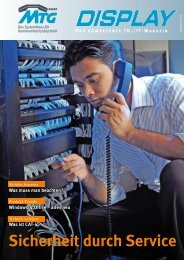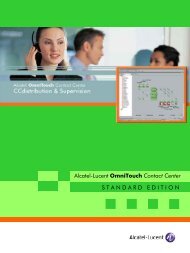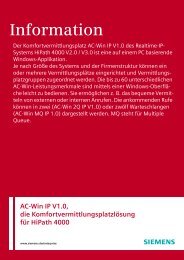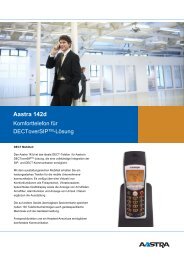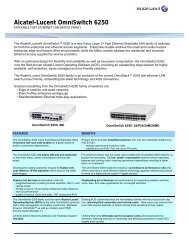Alcatel-Lucent OmniVista 2500 & 2700
Alcatel-Lucent OmniVista 2500 & 2700
Alcatel-Lucent OmniVista 2500 & 2700
Create successful ePaper yourself
Turn your PDF publications into a flip-book with our unique Google optimized e-Paper software.
<strong>Alcatel</strong>-<strong>Lucent</strong> <strong>OmniVista</strong> <strong>2500</strong> & <strong>2700</strong><br />
Delivering the Best Manageability<br />
for the Enterprise
“<strong>Alcatel</strong>-<strong>Lucent</strong>’s<br />
<strong>OmniVista</strong> network<br />
management<br />
simplifies network<br />
operations by<br />
improving network<br />
availability and<br />
security, while<br />
reducing costs.”<br />
> 2 ALCATEL-LUCENT<br />
Network management today<br />
Network management was supposed to be simpler now that many of the older networking technologies<br />
have become obsolete. Instead, it has become more complex from needing to protect against the<br />
ever changing security threats and the implementation of new services and technologies such as<br />
wireless access. Network manageability has also increased in importance as IT managers are facing a<br />
proliferation of converged, mission critical applications with unpredictable and rapidly growing network<br />
traffic. Network management applications must address security, network integrity, mobility and<br />
convergence infrastructure issues. It must also continue to support existing services with improved<br />
availability and service level agreements (SLAs).<br />
Add to this the fact that companies are experiencing budget cuts and staff reductions forcing them<br />
to do more with less. Clearly, network management plays a critical role in addressing these issues.<br />
Enterprise networks need a network management system (NMS) that reduces overall operational<br />
costs allowing IT resources and expertise to be deployed in more strategic locations.<br />
<strong>OmniVista</strong> <strong>2500</strong> & <strong>2700</strong><br />
<strong>Alcatel</strong>-<strong>Lucent</strong> <strong>OmniVista</strong> <strong>2500</strong> and <strong>2700</strong> provide a comprehensive set of network management<br />
applications and tools that simplify the management of <strong>Alcatel</strong>-<strong>Lucent</strong> and third party networking<br />
devices. <strong>OmniVista</strong> solutions allow managers to monitor network activity, configure and troubleshoot<br />
each device, as well as manage an entire network from a single platform.<br />
<strong>OmniVista</strong> has a true client / server architecture that allows multiple users to access its services<br />
simultaneously either through a Java-based client or through Web browser application. It delivers<br />
network level management while providing access to various element managers. <strong>OmniVista</strong> offers<br />
the following:<br />
• Scalable client/server/database architecture for large infrastructure<br />
• Centralized, cohesive management with a common intuitive look and feel<br />
• Network-wide visibility with topology view<br />
• Contextual integration with element manager<br />
• Device group manager for logical association and operation efficiency<br />
• Scheduler available for automation of repetitive operations<br />
• Alarms monitoring with smart responders<br />
• Northbound interface for monitoring automation<br />
• Device configuration backup/restore and software version management<br />
• VLAN provisioning and troubleshooting<br />
• Policy-based QoS for voice and data performance optimization<br />
• Network quarantine to contain potential threats<br />
• Policy-based access control list for network resource access
<strong>Alcatel</strong>-<strong>Lucent</strong> <strong>OmniVista</strong> <strong>2500</strong> & <strong>2700</strong><br />
Plus, <strong>OmniVista</strong> is easy to learn, saving network managers’ time while<br />
improving service levels. <strong>OmniVista</strong> also ensures a safe and secure<br />
infrastructure through extensive network access control, customizable<br />
security policies based on business needs and services, and the elimination<br />
of threats from misbehaving devices by quarantine and isolation.<br />
<strong>Alcatel</strong>-<strong>Lucent</strong> overall manageability<br />
<strong>Alcatel</strong>-<strong>Lucent</strong> addresses NMS problems and concerns by designing<br />
switches that provide management through easy to use interfaces<br />
with a common look and feel. Users get to select an interface they're<br />
most comfortable with including command line interfaces (CLI),<br />
WebView, or <strong>OmniVista</strong>.<br />
CLI – command line interface<br />
Even with today's sophisticated graphical user interfaces (GUI), engineers frequently prefer to use<br />
command line interfaces (CLI) for initial configuration of switches / routers. It reduces configuration<br />
time as they are able to gather a wide range of configuration information from one set of<br />
commands. Plus, ascii-based configuration files can be copied and pasted from one switch to<br />
another. <strong>Alcatel</strong>-<strong>Lucent</strong> simplified it further by ensuring that the commands are the same for all<br />
<strong>Alcatel</strong>-<strong>Lucent</strong> OmniSwitch platforms and have 100% of the functionality of WebView.<br />
WebView – management from the Web<br />
<strong>Alcatel</strong>-<strong>Lucent</strong> WebView is a web-based element manager that has the equivalent functionality of a<br />
CLI with the common look and feel of the <strong>OmniVista</strong> <strong>2500</strong> and <strong>OmniVista</strong> 4760 NMS platforms.<br />
<strong>OmniVista</strong> 4760 supports the OmniPCX family of PBXs and IP telephony. WebView with a devicecentric<br />
view was designed to be intuitive, minimizing the time required to learn a feature and<br />
configure it.<br />
<strong>OmniVista</strong><br />
WebView, the <strong>Alcatel</strong>-<strong>Lucent</strong> LAN switch<br />
element manager, complements <strong>OmniVista</strong><br />
network management tools<br />
<strong>OmniVista</strong> <strong>2500</strong> and <strong>2700</strong> are a comprehensive set of network management applications and tools<br />
that simplify the management of <strong>Alcatel</strong>-<strong>Lucent</strong> networking and third-party devices through a userfriendly,<br />
graphical user interface (GUI). <strong>OmniVista</strong> provides a centralized, global view of the network.<br />
It allows network managers to perform bulk operations saving time and preventing errors that can<br />
occur from repetitive tasks. The manager doesn’t have to touch every switch since <strong>OmniVista</strong> takes<br />
care of it.<br />
<strong>OmniVista</strong> increases productivity because of its simplicity and scalability. Its graphical user interface<br />
has a minimal learning curve because it has the same look and feel across all applets, it is inclusive,<br />
and offers OneTouch point-and-click technology.<br />
“WebView is<br />
simply the network<br />
industry’s best<br />
element manager<br />
web interface.”<br />
ALCATEL-LUCENT 3 >
4 ALCATEL-LUCENT<br />
<strong>OmniVista</strong>, an SNMP-based (v1, v2c, and v3) platform, allows managers to monitor network activity,<br />
configure and troubleshoot each device, as well as manage an entire network from a single platform.<br />
<strong>OmniVista</strong> offers bulk, automated, and standardized operations across the entire network.<br />
<strong>OmniVista</strong> Provides<br />
Centralized management: simplifies management and improves control by having a single, centralized<br />
repository of network administrators and their credentials.<br />
Unified management and network visibility: provides a common graphical interface and network<br />
management infrastructure for performing management functions, integrating applications, and unifying<br />
element management across multiple devices.<br />
Network-wide visibility: gives managers an extensive view and reporting of network activity with<br />
functions such as discovery, physical, and logical topology maps including spanning tree domains,<br />
centralized event management, graphs, and statistical information.<br />
Web browser interface for <strong>OmniVista</strong> client: allowing anytime , anywhere access to critical data<br />
for monitoring and troubleshooting operations for optimal network availability.<br />
Element management: integration provides direct access to each device through its native element<br />
manager and allows all networking devices to be configured from a centralized location.<br />
Policy-based QoS: a simplified, policy-based QoS management that can be used across multiple switches.<br />
Secure device access: centralizes control of switch administration access rights. Offers OneTouch<br />
setup of user login, password, and partitioned management (user credentials and access rights).<br />
Network quarantine: eliminates threats and security alerts from misbehaving devices by providing<br />
automation for quarantine and isolation.<br />
Policy-based network access control: Security is enhanced using network access control lists (ACL)<br />
as well as OneTouch and Expert modes for creating, administrating, and updating ACLs from a<br />
centralized platform.<br />
Scalable architecture: provides single-user and multi-user versions with an extensible architecture<br />
plus applications that allow the <strong>OmniVista</strong> NMS environment to be tailored to the user's network and<br />
budget needs<br />
<strong>OmniVista</strong> Network Management System<br />
<strong>OmniVista</strong> consists of:<br />
• <strong>OmniVista</strong> <strong>2500</strong>, which is the core application for network-wide management<br />
configuration and monitoring tasks<br />
• <strong>OmniVista</strong> <strong>2700</strong>, which consists of supplemental applications extending<br />
configuration for complex settings such as security operations, performances and<br />
automation of monitoring.
<strong>OmniVista</strong> <strong>2500</strong> Network Management Services<br />
The <strong>OmniVista</strong> <strong>2500</strong> application is the foundation for managing networks composed of <strong>Alcatel</strong>-<strong>Lucent</strong><br />
and other network devices. The <strong>OmniVista</strong> <strong>2500</strong> family gives administrators a unified view of the<br />
network as well as the necessary functions and services required to support next generation devices<br />
and applications. It features centralized management, bulk operations, simplicity, and scalability.<br />
It adheres to the essential network management functions of the FCAPS model (fault, configuration,<br />
accounting, performance, security) including:<br />
• Discovery of all <strong>Alcatel</strong>-<strong>Lucent</strong> and third-party SNMP network devices<br />
• Topology maps with interconnection links and performance information<br />
• Network-wide display of spanning tree domains<br />
• Multi-level user administration and security credential<br />
• Events and alarms management, including action on events, which are based on severity<br />
and action profiles<br />
• Statistics and health monitoring with alarms and thresholds<br />
• Inventory reports and switch auditing features<br />
• Automatic creation of VLANs across multiple switches<br />
• Locator for simplifying troubleshooting, by locating AOS and third-party devices based on<br />
port settings, location, IP/MAC addresses and DNS.<br />
• Automated and scheduled backup and restoration of device configuration<br />
• Automated download of new switch software image files<br />
• <strong>OmniVista</strong> Server Backup – an application for constant replication of the network<br />
management software environment<br />
By providing centralized operations, the infrastructure is optimized and deployment is simplified.<br />
Network device discovery and topology maps provide both physical and logical views of the network.<br />
Users are able to automate operations such as CLI scripting, create VLANs across multiple devices, and<br />
provide third party device support.<br />
Centralized operations also optimizes troubleshooting since it is easier to monitor the health of the<br />
network using a combination of alarm information, the locator service for pinpointing user location,<br />
and the trap responder for taking quick, automated action when there is an event. Health and<br />
statistic information is also readily available.<br />
Discovery<br />
<strong>Alcatel</strong>-<strong>Lucent</strong> <strong>OmniVista</strong> <strong>2500</strong> & <strong>2700</strong><br />
<strong>OmniVista</strong> <strong>2500</strong> provides the ability to control the discovery of <strong>Alcatel</strong>-<strong>Lucent</strong> LAN switches,<br />
OmniAccess wireless devices and third-party devices the IT staff member wishes to manage. Through<br />
the topology applications, all supported devices are discovered, device lists can be sorted by IP<br />
address, type, etc., and there is a dynamic indicator showing the status of each device.<br />
ALCATEL-LUCENT 5 >
Discovery and Topology for device mapping and<br />
inter-connection links<br />
> 6 ALCATEL-LUCENT<br />
Topology and Spanning Tree Map<br />
A topology map built within <strong>OmniVista</strong> <strong>2500</strong> can help the user determine<br />
where problems are and rapidly fix them. Using the topology map, a user<br />
can quickly determine network issues based on the dynamic, color-coded<br />
status feature so that a user can pinpoint current and impending problems<br />
at a glance. All <strong>Alcatel</strong>-<strong>Lucent</strong> devices and third-party devices are supported.<br />
Topology also allows the network manager to launch specific applications<br />
and as http-based management for the OmniAccess wireless devices and<br />
any other third-party element management applications.<br />
Network-wide spanning tree domains are visualized as well on the topology<br />
application allowing the network administrator to quickly identify spanning<br />
tree instances, VLAN associations, and ports status.<br />
VLAN Manager<br />
The <strong>OmniVista</strong> <strong>2500</strong> VLAN Manager allows users to create and manage VLANs across multiple switches.<br />
Through the manager, it's possible to:<br />
• Define a VLAN template to speed up new device introductions such as:<br />
copy existing VLAN definition to a new device, copy devices to a new VLAN,<br />
and apply VLAN rules to a user defined group of switches<br />
• Assign ports to VLANs<br />
• Define IP/IPX routing rules, and assign routing interfaces<br />
• Define mobility rules<br />
The VLAN manager also supports 802.1Q as well as spanning tree, and it's integrated with the<br />
topology database, making all of these functions possible. Combined with the VLAN browser<br />
capabilities, <strong>OmniVista</strong> can reduce planning and the troubleshooting associated with complex<br />
vlan setup.<br />
Resource Manager<br />
The <strong>OmniVista</strong> <strong>2500</strong> Resource Manager provides control of switch software and switch configuration<br />
for automated backup / restoration of configurations and software image files, and allows bulk<br />
download of software images. The Resource Manager allows network administrators to shift from a<br />
device centric to a network centric view, maximizing the IT staffs' productivity. This also decreases the<br />
number of administrators required to maintain the network and increases the number of remote<br />
locations that can function without IT resources. Incremental backup support helps network<br />
administrators to maintain up to date complex configurations. Lastly, equipment standardization<br />
enables automation of many tasks including<br />
switch reboot.<br />
Resource Manager saves time and IT resources, it reduces human errors and remediation cost, simplifies<br />
software by standardizing across networks, and optimizes the network infrastructure with reduced<br />
mean time to recovery (MTTR).
<strong>Alcatel</strong>-<strong>Lucent</strong> <strong>OmniVista</strong> <strong>2500</strong> & <strong>2700</strong><br />
Interactive CLI<br />
<strong>Alcatel</strong>-<strong>Lucent</strong> Operating System (AOS) devices support command line<br />
interface (CLI) scripting, which saves time by allowing repetitive CLI<br />
tasks to be pushed simultaneously across multiple devices, such as in<br />
the initial configuration of multiple network devices or when global<br />
changes such as SNMP community strings are needed. CLI scripting was<br />
designed to be clean and simple, yet be able to consolidate a wide<br />
range of configuration information into one set of commands.<br />
Commands can be copied and distributed from one switch to several<br />
others because the commands are standardized across all AOS devices.<br />
Users can set up context-based CLI commands; define variables to be<br />
used in commands within the session.<br />
Repetitive tasks such as password changes or device audits can be<br />
automated and scheduled with CLI scripting as well as multiple device<br />
CLI query or set actions. The automation of all of these tasks saves IT<br />
manager time resulting in cost savings, reduction in human errors,<br />
and optimization of the IT staffs’ time.<br />
Troubleshooting Optimization<br />
<strong>OmniVista</strong> <strong>2500</strong> has optimized troubleshooting allowing users to<br />
monitor the health of the network and set alarm thresholds to<br />
provide early warning of potential problems before they become<br />
critical events. Devices that have tripped alarms can be located, and<br />
through event management, immediate automatic action can be<br />
taken on the event. The trap responder automatically notifies<br />
personnel of the problem and automatic actions can be triggered in<br />
response, reducing demands on the help desk.<br />
Resource Manager simplifies<br />
device configuration management<br />
and standardization<br />
Locator<br />
CLI scripting can send telnet commands<br />
<strong>OmniVista</strong> <strong>2500</strong> Locator is one of the first mechanisms to defend the across multiple devices at once, avoiding<br />
network against security threats. With the Locator function, the<br />
repetitive tasks<br />
network is better able to isolate problem resources through increased<br />
awareness of what is on the network. Locator enables quick identification of hostile elements with<br />
maximum information for problem-solving at a glance.<br />
As the name implies, this troubleshooting tool uses a combination of Address Resolution Protocol<br />
(ARP) and bridge forwarding tables in <strong>Alcatel</strong>-<strong>Lucent</strong> switches (and any other RFC 1493 compliant<br />
device) to identify the <strong>Alcatel</strong>-<strong>Lucent</strong> connection (i.e., switch, slot/port, speed, mode, VLAN ID, MAC<br />
and IP addresses, DNS) with the problem.<br />
Locator supports live and historical searches to trace where a specific address is located at a particular<br />
timestamp complete with a history of where the user has moved within the network. It also allows<br />
browsing, sorting and filtering of devices. Locator lets the administrator quickly pinpoint hostile<br />
ALCATEL-LUCENT 7 >
8 ALCATEL-LUCENT<br />
elements enabling a quicker containment of problems. It also enhances an administrator's access<br />
control to the network providing a first line of defense against security hazards. It supports a “rightclick”<br />
menu for direct interaction with other <strong>OmniVista</strong> applications such as the Quarantine Manager<br />
and VLAN Manager to expedite trouble shooting and problem resolution.<br />
Lastly, Locator is able to discover non-AOS devices from third-party vendors and offers an option to<br />
find the closest AOS switch to the third-party device and draw a link on the topology map.<br />
Performance - Health & Statistics<br />
<strong>OmniVista</strong> <strong>2500</strong> allows users to get performance information from multiple devices at once enabling<br />
users to correlate information and analyze network-wide activities. Early detection of problems<br />
provides opportunities for pre-emptive actions to be taken. <strong>OmniVista</strong> allows the user to monitor the<br />
network's health through the use of thresholds on specific parameters providing early awareness and<br />
constant visibility of the network’s health. When the threshold is crossed, a trap is sent to the<br />
Notifications application to warn the admin of the problem.<br />
Statistics<br />
<strong>OmniVista</strong> <strong>2500</strong> constantly monitors the network, using multiple profiles and collected statistics<br />
from across multiple devices and modules at a time, which are viewable on a common graph or<br />
information table. These profiles are from parallel critical links to the backbone, servers and uplinks<br />
that show when the events happened. With constant monitoring of CPU use, <strong>OmniVista</strong> is able to<br />
detect critical events such as worms and other security threats. Statistics are available on <strong>Alcatel</strong>-<br />
<strong>Lucent</strong> Operating System (AOS), and any third-party device compliant with RFC 1493.<br />
The statistics application provides a holistic view of the network’s performance by understanding the<br />
behavior and pattern of the devices and users. This application is the “eyes and ears” of the network,<br />
providing the network administrator constant visibility for an instant snapshot and early awareness of<br />
any issues in the network. This early detection of potential problems leads to pre-emptive actions and<br />
reaction helping ensure high network performance levels.<br />
<strong>OmniVista</strong> <strong>2500</strong> Summary<br />
The centralized structure of <strong>OmniVista</strong> reduces the administrative burden on the IT staff when<br />
managing complex operations for multiple switches across the network. The same approach is used<br />
in the <strong>OmniVista</strong> <strong>2700</strong> services to manage complex settings such as data, voice, and security.<br />
With PolicyView, network performance optimization for voice and data is made simpler. The<br />
centralized approach for secure device access and network access policy management is effortless<br />
with SecureView family series as well with the Quarantine Manager for containment management.
<strong>Alcatel</strong>-<strong>Lucent</strong> <strong>OmniVista</strong> <strong>2500</strong> & <strong>2700</strong><br />
<strong>OmniVista</strong> <strong>2700</strong> supplemental services<br />
The <strong>OmniVista</strong> <strong>2700</strong> supplemental services are optional software<br />
applications that provide flexibility and automation. They include:<br />
• <strong>OmniVista</strong> 2730 – PolicyView<br />
• <strong>OmniVista</strong> 2750 – SecureView Switch Access<br />
• <strong>OmniVista</strong> 2760 – SecureView ACL<br />
• <strong>OmniVista</strong> 2770 – Quarantine Manager<br />
• <strong>OmniVista</strong> 2790 - Web Services<br />
These applications can be added to the <strong>OmniVista</strong> environment as<br />
desired to extend the capabilities of <strong>OmniVista</strong> NMS.<br />
<strong>OmniVista</strong> 2730 PolicyView with OneTouch QoS: simplifies the<br />
Statistics application is for observing traffic<br />
complex task of configuring QoS and enables enhanced policy-based<br />
patterns and early signs of changes<br />
management across multiple devices through OneTouch simplicity. The<br />
parameters are set once and distributed to the devices. This reduces the number of interfaces needed<br />
for configuring QoS for VoIP and time critical data operations.<br />
The three modes of operation are:<br />
• OneTouch for voice, which simplifies quality of service (QoS) configurations for voice<br />
over Internet Protocol (VoIP) networking<br />
• OneTouch for data, which allows selected servers to receive high priority traffic for<br />
mission critical applications<br />
• Expert Mode, which provides policy validation of conditions, classifications, actions,<br />
and attributes as well as complete QoS control<br />
<strong>OmniVista</strong> 2730’s policy rule validation element checks arguments across a features and conditions<br />
matrix of <strong>Alcatel</strong>-<strong>Lucent</strong> operating system releases and against conflicting condition attributes and<br />
then flags inconsistencies. <strong>OmniVista</strong> 2730 simplifies all policy-based network-wide operations with its<br />
OneTouch effort.<br />
<strong>OmniVista</strong> 2750 SecureView Switch Access: centralizes control of switch administration access<br />
rights and policies with OneTouch manageability. In essence, the <strong>OmniVista</strong> 2750 provides centralized<br />
control over and knowledge of who, what, how, and when users and devices are allowed into the<br />
network and minimizes human errors through automation. It offers management for simplified setup<br />
of a centralized repository (such as an LDAP directory), users, passwords, access rights, etc., reducing<br />
password management complexity.<br />
<strong>OmniVista</strong> 2750 is part of <strong>Alcatel</strong>-<strong>Lucent</strong>'s overall security strategy called CrystalSec, which is <strong>Alcatel</strong>-<br />
<strong>Lucent</strong>’s security framework and architecture. Security is provided between each network layer<br />
allowing organizations to create multiple layers of defense around important assets.<br />
ALCATEL-LUCENT 9 >
“The Quarantine<br />
Manager provides<br />
us a deeper level<br />
of security<br />
protection from<br />
intrusion threats.”<br />
> 10 ALCATEL-LUCENT<br />
<strong>OmniVista</strong> 2760 SecureView ACL: is a component of <strong>Alcatel</strong>-<strong>Lucent</strong>’s CrystalSec security framework<br />
that simplifies and automates the complex task of configuring network security policies by using<br />
access control lists (ACLs). Once a policy is defined, <strong>OmniVista</strong> 2760 allows the administrator to apply<br />
it to every device, all at once.<br />
By deploying this optional application, an IT department is able to increase their productivity by<br />
eliminating the repetitive tasks of network management and by preventing security breaches and<br />
inadequate network access policies. This limited need to touch the network saves bandwidth that can<br />
be put towards more appropriate usage support the company’s business. <strong>OmniVista</strong> 2760 SecureView<br />
ACL provides the network better security and the administrator total control over vital resources and<br />
their accessibility.<br />
Access control lists are created centrally, administrated through a common central repository, and<br />
updated for traffic security and network services. <strong>OmniVista</strong> 2760 provides:<br />
• OneTouch Wizard, with its single page setup, simplifies network configuration and<br />
creation of network model, leveraging the network groups capability.<br />
• An advanced, Expert mode for creating and modifying complex ACLs. This mode enables<br />
modifications such as device assignment, defining policy validity period, supports<br />
various Traffic conditions such as L2/L3 destination /source address, L4 conditions,<br />
VLAN IDs, subnets, network groups and applications.<br />
<strong>OmniVista</strong> 2770 Quarantine Manager: The Quarantine Manager combines network management<br />
and network security into one application that can be used to manage and secure a wired/wireless<br />
infrastructure. The Quarantine Manager protects the network from attacks at the network and<br />
application level by isolating the misbehaving user and providing a means for remediation.<br />
Rules and decisions can be pre-configured using OneTouch automation for handling a security<br />
event once it is detected. Detection and notification of a security breach are initiated from<br />
IDS/IPS external devices. The notification (trap) can also be sent by <strong>Alcatel</strong>-<strong>Lucent</strong> AOS devices<br />
when under denial of service attack. These alerts are handled either through the pre-configured<br />
quarantine decisions (rules) or manually through the expert mode.<br />
The network administrator has complete control over the quarantine operations through a user<br />
interface that provides status and override capabilities as well as the ability to segment the network<br />
for selective containment domains. There is also a candidate list window for screening potential<br />
intruders before isolating and banning them and a window where intruders may be automatically<br />
banned or identified as never ban. There is a release window for threats that have been assessed and<br />
dismissed or because the device now conforms.<br />
Containment is possible by several methods including quarantine VLAN, by shutting down ports, by<br />
blacklisting misbehaving wireless end-users, and through containment based on network access<br />
policies (access control lists).
<strong>Alcatel</strong>-<strong>Lucent</strong> <strong>OmniVista</strong> <strong>2500</strong> & <strong>2700</strong><br />
The quarantine VLAN method consists of the network administrator<br />
isolating the offending intruders by pushing them into a dedicated<br />
quarantine VLAN based on the intruder’s MAC-address. This method can<br />
be used with all AOS-based devices with group mobility enabled.<br />
The Quarantine Manager uses intruder containment by port shutdown<br />
when any third-party MIB-II compliant network device is misbehaving.<br />
The port is shut down to prevent further access and can be restored<br />
through the Quarantine Manager as well.<br />
OmniAccess wireless LAN end-users who show signs of bad behavior and<br />
are detected by IDS/IPS are blacklisted to prevent access through any<br />
other access points.<br />
The last containment method is the use of network access policies (ACL),<br />
which is accomplished through <strong>OmniVista</strong> 2760 SecureView ACL. The<br />
identified intruder’s MAC-address is pushed into a centrally created ACL.<br />
Quarantine Manager receives notification of<br />
events triggering security alerts and<br />
generating quarantine decisions<br />
The Quarantine Manager has extensive quarantine history log files and provides MAC / IP tracing<br />
associations for troubleshooting and intrusion control. The Quarantine Manager also offers external<br />
notification capabilities for IT shops and helpdesk ticket practices.<br />
In summary, Quarantine Manager extends <strong>Alcatel</strong>-<strong>Lucent</strong> NMS benefits such as centralization and<br />
automation by converging network management and network security under a unique application.<br />
<strong>OmniVista</strong> 2790 Web Services: The <strong>OmniVista</strong> 2790 Web Services module provides a northbound<br />
interface for easy integration with diverse network management applications. The OV2790 optional<br />
application is based on Web Services technology, relying on Extensible Markup Language (XML) and<br />
scripting languages (Java, PHP, Perl), for easy integration with other software environments. XMLbased<br />
Web Services provide application interoperability. XML provides a flexible encoding mechanism<br />
that is human readable and is able to support programmatic operations. <strong>OmniVista</strong> Web Services<br />
enables independent software vendor (ISV) partners, the IT Departments, and system integrators to<br />
use widely available, open source software development tools to integrate <strong>OmniVista</strong> <strong>2500</strong> and <strong>2700</strong><br />
into their application and network management environment.<br />
<strong>OmniVista</strong> 2790 offers total management access using the <strong>OmniVista</strong> GUI for the functionalities<br />
supported such as discovery, topology, notification, and locator operations. It’s ideal for automating<br />
frequent monitoring tasks such as IT dashboard, allowing network administrators to quickly gauge<br />
effects of interrelated events by converging critical metrics from multiple sources.<br />
The <strong>OmniVista</strong> 2790 Web Services interfaces can be combined with <strong>Alcatel</strong>-<strong>Lucent</strong> 5620 Service Aware<br />
Manager (SAM) and its XML open interface provides easy integration into OSS environments. This<br />
enables service providers to build Web-portal interfaces that allow easy, flexible service provisioning,<br />
to quickly address market reactions.<br />
ALCATEL-LUCENT 11 >
<strong>Alcatel</strong>-<strong>Lucent</strong> provides advanced,<br />
simplified intrusion containment and<br />
security for <strong>Alcatel</strong>-<strong>Lucent</strong> and<br />
multi-vendor networks<br />
> 12 ALCATEL-LUCENT<br />
Summary<br />
The flexibility of Web Services provides a more efficient OSS/BSS-to-network<br />
communication, with faster turnaround times, and less overhead and effort.<br />
For example, the <strong>OmniVista</strong> 2790 Web Services solution can be used as a single,<br />
flexible point of access for end-to-end user service configuration for the <strong>Alcatel</strong>-<br />
<strong>Lucent</strong> OmniPCX IP Telephony and VoIP solution.<br />
In summary, <strong>OmniVista</strong> 2790 Web Services simplifies the introduction of <strong>Alcatel</strong>-<br />
<strong>Lucent</strong> Enterprise IP solutions in large complex environments. <strong>OmniVista</strong> 2790 Web<br />
Services reduces cost, time and risk associated with OSS/BSS and process automation.<br />
It makes <strong>OmniVista</strong> <strong>2500</strong> and <strong>2700</strong> plug-and-play in complex, heterogeneous<br />
environments. Web Services makes <strong>OmniVista</strong> <strong>2500</strong> and <strong>2700</strong> Network Management<br />
Solutions and its data structure scriptable and accessible to open environments.<br />
<strong>Alcatel</strong>-<strong>Lucent</strong> <strong>OmniVista</strong> <strong>2500</strong> and <strong>2700</strong> applications deliver the best value in the industry by<br />
providing simplified management that creates a secure, reliable network infrastructure. Implementing<br />
<strong>OmniVista</strong> reduces overall administrative costs, and minimizes the maintenance required, which<br />
results in an improved return on investment.<br />
<strong>OmniVista</strong> <strong>2500</strong> and <strong>2700</strong> applications provide better network availability by anticipating potential<br />
risks and reacting to important events resulting in less downtime and improved productivity. The<br />
northbound interface makes the <strong>OmniVista</strong> solution easier to integrate into the existing network<br />
application framework, simplifying data sharing.<br />
By controlling the access to the network, <strong>OmniVista</strong> <strong>2500</strong> and <strong>2700</strong> network management applications<br />
protect the infrastructure from attacks and security risks while limiting financial exposure. Moreover,<br />
simplified management operations coupled with a consistent set of tools across all network devices,<br />
minimizes the difficulty of implementing and monitoring the network infrastructure.
<strong>Alcatel</strong>-<strong>Lucent</strong> <strong>OmniVista</strong> <strong>2500</strong> & <strong>2700</strong><br />
Comprehensive, extensive manageability across <strong>Alcatel</strong>-<strong>Lucent</strong> equipment and third-party devices<br />
Features Supported<br />
by Device Family<br />
OmniSwitch AOS series (1)<br />
OmniStack 6200 series<br />
OmniAccess WLAN series<br />
<strong>Alcatel</strong>-<strong>Lucent</strong> 7750 Service<br />
Router (SR) series & 7450<br />
Ethernet Service Switch (ESS) series<br />
3rd party device w/ SNMP support<br />
& MIB-2 compliant<br />
Infrastructure Deployment & Configuration<br />
Discovery & Topology<br />
Trap Management<br />
with "Action on Event"<br />
CLI / Telnet Launch<br />
Web based Element Mgr<br />
or third party app launch<br />
VLAN provisioning<br />
through Wizard<br />
Performances Monitoring & Troubleshooting Automation of<br />
Operations<br />
(1) Covers <strong>Alcatel</strong> AOS OmniSwitch 6600, 6800, 7000, 9000 series.<br />
(2) Web Services based Northbound interface API coverage included topology, discovery, notifications, locator functionalities.<br />
Web Services required for <strong>OmniVista</strong> http client support.<br />
AWV <strong>Alcatel</strong>-<strong>Lucent</strong> WebView, http-based Element<br />
Manager for the next generation AOS-based<br />
<strong>Alcatel</strong>-<strong>Lucent</strong> OmniSwitch.<br />
It provides advanced capabilities that are easy<br />
to use for configuring the OmniSwitch family.<br />
<strong>OmniVista</strong> <strong>2500</strong> Core Application<br />
Locator<br />
Device MIB Browsing<br />
Utilization & Statistics<br />
Inventory Reports<br />
Health<br />
WBM Embedded http-based management system<br />
allowing access to devices with a standard<br />
Web browser for ease of management.<br />
Interactive Telnet<br />
Resource Manager<br />
<strong>OmniVista</strong> <strong>2700</strong><br />
Supplemental Applications<br />
PolicyView 2730<br />
Security, Performances Optimization,<br />
Northbound Interface<br />
SecureView SwitchAccess<br />
2750<br />
SecureView ACL 2760<br />
Quarantine Manager<br />
2770<br />
Web Services (2)<br />
22790<br />
ALCATEL-LUCENT 13 ><br />
Element<br />
Manager<br />
User interface type<br />
AWV<br />
WBM<br />
WBM<br />
5620<br />
SAM<br />
WBM<br />
5620 SAM <strong>Alcatel</strong>-<strong>Lucent</strong> 5620 SAM, Client/Server<br />
NMS application for advanced device and<br />
services configuration for <strong>Alcatel</strong>-<strong>Lucent</strong><br />
7750 SR and 7450 ESS series.
14 ALCATEL-LUCENT<br />
System Requirements for <strong>OmniVista</strong> <strong>2500</strong> and <strong>2700</strong> Environments<br />
Supported Platforms and Minimum OS<br />
Minimum CPU Speed and Type<br />
Minimum RAM Required<br />
Minimum Disk Required<br />
Browsers Supported<br />
* Supports 32 & 64 bits environments<br />
<strong>OmniVista</strong> <strong>2500</strong> & <strong>2700</strong> <strong>OmniVista</strong> <strong>2500</strong> & <strong>2700</strong><br />
Multi-user configuration Single-user configuration<br />
Microsoft Windows Server<br />
2003 (server side), Windows XP<br />
Pro (client side only)<br />
Sun Solaris 10*<br />
(server & client side)<br />
Red Hat Enterprise Linux ES &<br />
Novell SUSE version 10*<br />
(server & client side)<br />
For MS Windows & Linux:<br />
Pentium 4 with 2 Ghz or better<br />
(server side) - Pentium 4 with 1<br />
Ghz or better (client side)<br />
For Sun Solaris: UltraSparc 5<br />
processor or higher<br />
2 GB RAM or more (server side)<br />
on MS Windows<br />
1 GB RAM or more (client side)<br />
on MS Windows<br />
4 GB RAM or more (server side)<br />
on Linux & Solaris 64 bits<br />
environments<br />
Min 5 GB free disk space<br />
(server side) - Min 2 GB free<br />
disk space (client side)<br />
Microsoft Internet Explorer 6.0.<br />
Mozilla FireFox 2.0<br />
Microsoft Windows Server<br />
2003, Windows XP Pro<br />
Sun Solaris 10*<br />
Red Hat Enterprise Linux ES,<br />
Novell SUSE 10*<br />
For MS Windows & Linux:<br />
Pentium 4 with 2 Ghz<br />
(or better)<br />
For Sun Solaris: UltraSparc 5<br />
processor or higher<br />
2 GB RAM or more (MS<br />
Windows)<br />
4 GB RAM or more (server side)<br />
on Linux & Solaris 64 bits<br />
environments<br />
Min 5 GB free disk space<br />
Not supported with <strong>OmniVista</strong><br />
2520 Basic Single User
Ordering Information<br />
<strong>Alcatel</strong>-<strong>Lucent</strong> <strong>OmniVista</strong> <strong>2500</strong> & <strong>2700</strong><br />
Application Part Number Product description<br />
<strong>OmniVista</strong> <strong>2500</strong> Core Applications OV2520-BSU-R3 <strong>OmniVista</strong> 2520 Basic Single-user version<br />
OV2540-BMU-R3 <strong>OmniVista</strong> 2540 Basic Multi-user version<br />
<strong>OmniVista</strong> <strong>2700</strong> Optional Applications OV2730-PVOT-R3 <strong>OmniVista</strong> 2730 PolicyView<br />
OV2750-SVSA-R3 <strong>OmniVista</strong> 2750 SecureView<br />
Switch Access<br />
OV2760-SVACL-R3 <strong>OmniVista</strong> 2760 SecureView ACL<br />
OV2770-QM-R3 <strong>OmniVista</strong> 2770 Quarantine Manager<br />
OV2790-WS-R3 <strong>OmniVista</strong> 2790 Web Services<br />
<strong>OmniVista</strong> <strong>2500</strong> and <strong>2700</strong> CD OV-NMS-CD-R3 <strong>OmniVista</strong> <strong>2500</strong> and <strong>2700</strong> applications CD -<br />
Requires individual activation license for<br />
each application<br />
Specific upgrades and software subscription programs are available through service and support will allows customer to<br />
stay current between major releases.<br />
Free 60 day evaluation versions for <strong>OmniVista</strong> <strong>2500</strong> and <strong>2700</strong> are available as well. Please contact your <strong>Alcatel</strong>-<strong>Lucent</strong><br />
representative or check the <strong>Alcatel</strong>-<strong>Lucent</strong> web site for further details.<br />
ALCATEL-LUCENT 15 >
www.alcatel-lucent.com<br />
<strong>Alcatel</strong>-<strong>Lucent</strong><br />
26801 West Agoura Road<br />
Calabasas, CA 91301 USA<br />
Contact Center<br />
(800) 995-2612 US/Canada<br />
(818) 880-3500 Outside US<br />
www.alcatel-lucent.com<br />
<strong>Alcatel</strong>, <strong>Lucent</strong>, <strong>Alcatel</strong>-<strong>Lucent</strong>, and the <strong>Alcatel</strong>-<strong>Lucent</strong> logo, are trademarks of <strong>Alcatel</strong>-<br />
<strong>Lucent</strong>. All other trademarks are the property of their respective owners. <strong>Alcatel</strong>-<strong>Lucent</strong><br />
assumes no responsibility for the accuracy of the information presented, which is subject<br />
to change without notice. (c) 2007 <strong>Alcatel</strong>-<strong>Lucent</strong>. All rights reserved.<br />
P/N 031879-00 3/07




